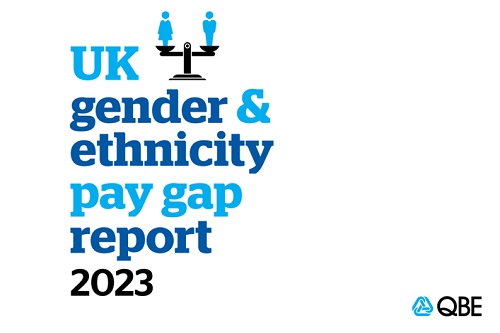QBE releases gender pay gap data for 2023

QBE UK has released its Gender & Ethnicity Pay Gap Report for 2023
The mean overall gender pay gap across the organisation was 21.9% in 2023, down from 24.7% in 2022, and 32.8% when it started reporting for 2017.
This compares to a gap of 35% in the insurance industry, 26.6% in the financial services industry and 8.3% for the UK economy.
QBE EO People Director, Nikki Lees said some of QBE’s enhanced and updated benefits package announced last year were helping drive change.
“We are committed to reducing the gap, whether that’s through our benefits, our partnerships, or our upskilling programme,” she said.
“While we have made progress to reducing our pay gap for gender and ethnicity, challenges remain and we continue to strive towards reducing these gaps.”
Its gender bonus pay gap increased from 50.1% in 2022 to 51.7% in 2023. It remains below the industry’s gender bonus gap, most recently recorded at 59% . In 2017, the bonus pay gap at QBE was 78.1%.
Lees said QBE was focussed on addressing this bonus pay gap.
“While progress has been made to reduce the gender pay gap at QBE, like the rest of the industry, the bonus pay gap remains an issue and more work needs to be done to reduce this. While the popularity of part time roles plays a contributing factor, higher bonus pay-outs to new senior male hires and joining start dates certainly skews the results,” said Lees.
“The removal of barriers to career progression through initiatives like equalised parental leave help challenge traditional gender roles both at home and at work. This in turn, will help reflect positively in a narrowed gender pay gap and increased equity in leadership.”
At a global level, QBE has met its end of 2025 target of reaching 40% Women in Leadership levels two years ahead of plan with more work needed to achieve this across all regions.
For the third time, QBE has published its ethnicity pay gap data and this has reduced from 10.4% in 2022 to 5.4% in 2023, reflecting its lowest level in the three-year period.
“Through our UK ethnicity targets we remain committed to increasing ethnic diverse representation at all levels of the organisation. Last year we also introduced new sense of belonging targets as we know equality of experience is just as important as representation levels.”
QBE welcomes first set of Dads back from parental leave
As a broader commitment to diversity and inclusion, QBE made several updates to its UK benefits including enhanced paternity leave in 2023.
Recent data from Pregnant Then Screwed and CPP shows increasing entitlement to paternity leave and pay could help close the gender pay gap and increase UK economic output by up to £23 billion.
All QBE employees in the UK can now receive 26 weeks at full pay and up to 52 weeks’ leave regardless of gender identity, sexual orientation, or how they become a parent.
Over the first year of QBE’s equalised parental leave policy, 56 fathers have taken up parental leave with 73% of those taking 22 weeks or more of full pay. An additional five men have taken over six months of parental leave, benefitting from extra time at home with their child beyond the paid allowance.
The average length of paternity leave taken at QBE rose from 8.6 days in 2022 to 150 days in 2023.
“Some of our fathers are just returning to work this month and we are hearing what a positive difference this leave had made for them and their families,” says Lees.
“Providing the right options like equal parental leave has a positive impact on gender equality more generally, reflecting the needs of dual career families, as time away from work to care for a child can be more equally split.
“Breaking down gender stereotypes and challenging the norms around who raises children in the home is a key piece of the puzzle. As an industry, I believe we have a role to play to raise our game and offer the policies that will remove barriers and help attract the next generation of financial services and insurance professionals”.
Sam Wade – case study – Lean Process Engineer, QBE EO.
When Sam Wade was first considering his paternity leave options, he had thought he would take around three months.
“Admittedly, I was concerned that if I was out of sight, I would be out of mind, unable to contribute and be relevant at an important time for the business. But then when my fiancé had a traumatic birth, I realised we really needed me to extend the leave” said Wade, 34, from East Sussex.
“I felt fortunate that when things didn’t go to plan, I was supported by QBE, and I was given flexibility to extend my paternity leave.”
Sam Wade is one of 56 fathers at QBE who have taken advantage of its new paternity leave policy, announced in 2023. He took six months of paid paternity leave.
“I was definitely part of the minority when it came to the antenatal class – most other fathers I met just got two weeks of leave and needed to top this up with annual leave,” he said.
Wade thinks it’s a good idea to plan as much as you can in advance of expecting a child for the first time.
“It’s good to have a contingency plan if things don’t go to plan. Being a new parent is not easy and I would encourage everyone to tap into the support networks available.
“Thanks to the supportive model provided by QBE, I am grateful to have had more time to build a strong relationship with my daughter, whilst also further contributing to the new day-to-day activities.
“The more fathers who take extended paternity leave, the better the understanding will be for more returning mothers,” Wade said.
Authored by QBE





